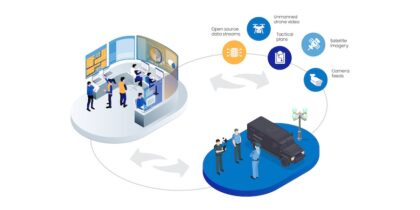Smartphones are introducing a new paradigm to policing, allowing officers to maintain full connectivity regardless of their access to a vehicle. In short, a “connected” officer is an effective officer due to better information access, increased situational awareness and the sheer utility that only a smartphone can offer. Properly applied smartphone technology can improve departmental efficiency and even power an in-vehicle computing experience, eliminating the need for laptops.
Technology comes with a price, however, and funding a program — even one that will ultimately result in savings — can be a challenge due to startup costs. That’s where grant funding can help an agency obtain tech capabilities that would otherwise be unavailable.
Grant Processes
There are several federal grant programs that provide assistance to agencies, making it possible to start new programs and expand existing capabilities. The amount of funding available and specific program details differ each year based on budgets and program emphasis. Many grants are dependent on certain criteria, such as proximity to an international border or urban region designated as having homeland security risk. Since different federal departments and agencies are involved, grant announcements take place at different times and sometimes are open for a relatively short period. For instance, 2018 FEMA grants for emergency communications equipment — including handheld broadband devices — were only open from May 21 to June 20.
It’s important to know the timing of a Notice of Funding Opportunity (NOFO) because it often signals the start of the application period. The best way to stay abreast of funding opportunities is to follow the federal grant clearinghouse, Grants.gov, which posts information on all federal grant notices and functions as the application portal for many federal grants. Agencies should sign up for email alerts on grant opportunities through Grants.gov and also review the funding resources listed in the “Emergency Communications Financial Assistance Programs Guide” for notification links tied to different programs. Another good source of information is the National Criminal Justice Reference Service, which publishes biweekly and weekly resources with information on grant solicitation releases and funding-related webinars. Both are available at no cost.
Reduce Costs with Samsung DeX In-Vehicle
Download the Public Safety Network's in-depth cost comparison on Samsung's DeX in-vehicle solution. Download Now
For some federal grants, eligible agencies can apply directly. For many other programs, applications for funding assistance must come from the state on behalf of the agencies. In these cases, agencies must submit a proposal through a state administrative agency (SAA). The SAA, in conjunction with other state officials, decides whether the project request will be included in the overall state grant application. The SAA process is becoming increasingly common, as federal authorities allow states to determine the priorities for their allocated funding. It is important that agencies develop a relationship with their SAA and understand the different grant opportunities and processes used within their state. A good place to start is the listing of SAA contacts maintained by FEMA.
Major Grant Funding Sources
FEMA, working through the Department of Homeland Security, oversees multiple grant programs that provide support to state, local, tribal and territorial public safety efforts. Funding is available for equipment acquisition, training and even staffing. The majority of FEMA funding is channeled through SAAs, underscoring the need for agencies to understand the submission and review processes specific to their states. FEMA-administered programs include:
- The State Homeland Security Program (SHSP), which provides funding to states, 80 percent of which must be passed on to local or tribal agencies
- The Urban Area Security Initiative (UASI), which provides funding to states, with 80 percent of the funding passed to specific high-risk urban areas
- The Port Security Grant Program (PSGP), which provides funding to state and local agencies that manage ports and port operations
- The Transit Security Grant Program (TSGP), which provides funding to public transit agencies (including their police forces) for homeland security preparedness
- Operation Stonegarden (OPSG), which provides funding to states dealing with border issues and is limited to agencies with proximity to the international border or international waters
- The Tribal Homeland Security Grant Program (THSGP), which provides funding for tribes to improve emergency preparedness
For agencies that are planning or considering a transition to the First Responder Network Authority (FirstNet), several of the above FEMA programs can provide support. However, FEMA requires that communication projects move through the Statewide Interoperability Coordinator and strongly recommends coordination with the FirstNet State Single Point of Contact.
The U.S. Department of Justice administers the Edward Byrne Memorial Justice Assistance Grant Program, commonly known as Byrne or JAG grants. This program is the leading source of federal funding for state and local criminal justice agencies. It supports a range of program areas including technology acquisition and expansion. A large portion of Byrne grants are administered by states, but there is also funding that is individually awarded through a federal process. Individual offerings can be found on Grants.gov. For information on how your state plans to distribute Byrne Grant funding, contact the administering state agency.
Six Steps to a Successful Grant Submission
- Determine what you want to accomplish. Think beyond simply acquiring equipment. Instead, outline what the technology will allow you to do. In other words, what problem, need or challenge exists that the technology will enable your agency to more effectively address? Also, think in terms of the funding source and the appropriate nexus. For instance, homeland security grants generally require information on how the grant funding will be used to improve preparedness or capabilities regarding domestic emergencies or terrorism.
- Consider regional or multi-agency partnerships. Some funding processes, such as UASI grants, actually require that there be a demonstrated regional benefit. Even when it’s not required, demonstrating a broader application can often improve your chances of approval.
- Review the extensive information on grant processes, policies, terminology and eligibility at Grants.gov. There’s also a mobile application that will help you search funding opportunities and receive notifications of new offerings.
- After you put together your draft proposal, have someone who is not part of the preparation effort review the document to ensure the narrative clearly conveys the benefits and purpose of your request.
- Pay careful attention to submission requirements including deadlines and methods of submission. Plan on filing your application well before the deadline to allow time to manage unforeseen challenges. Some grants have a short filing period after the announcement. Doing advance work in terms of program justification can help you be ready when an opportunity opens.
- Most grant processes require that the agency have a Data Universal Numbering System (DUNS) number and registration in the System for Award Management (SAM). There is also a registration procedure with Grants.gov. This process can take some time; if your agency has not already done so, make this a priority.
The opportunity for agencies to use technology effectively as a force multiplier has never been greater, and grant funding can help to make it possible. The process of obtaining a grant can seem daunting, but agencies should not be deterred from seeking assistance for worthwhile projects. Utilize the online resources provided in this article and you’ll be well on your way.
For assistance in planning a mobile-first initiative at your agency, check out The Ultimate Law Enforcement Agency Guide to Going Mobile.









